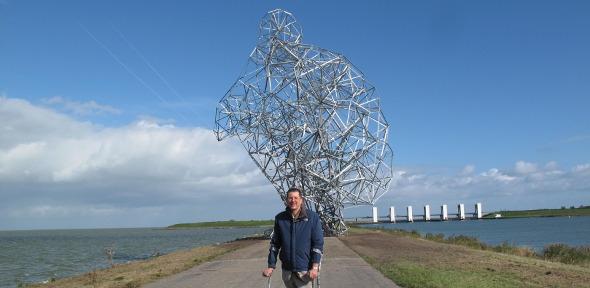
Professor Roberto Cipolla's software has been used by sculptor Antony Gormley to create a 60-tonne monumental sculpture called 'Exposure', in the Netherlands, it took Scottish pylon-makers and Dutch engineers six years to complete.
Roberto's work is unique in the world: it's extraordinary to get a fully rotational model from a standard single-lens digital camera.
Antony Gormley
26 metres (85ft) tall its components were fabricated by a pylon manufacturer in East Lothian and then shipped to the Netherlands for assembly. It is an object of mind-bending scale and complexity. It weighs 60 tonnes, contains 5,400 bolts and consists of 2,000 components. If this crouching man stood up, he would be over 100 metres tall; if an adult stands next to it, he or she may just be able to peek over its feet.
The first step in the making of the sculpture was for Gormley to cast himself in plaster – an "extremely uncomfortable" hour and a half, locked in a crouching position.
The next was to translate the solid form into a 3D computer model. Using software developed by Roberto and his team the form was digitised automatically from photographs.
Roberto's software can bring a handful of photographs of a sculpture to life as a high-resolution 3D computer model. Together with Dr Carlos Hernández Esteban, they have produced breathtaking results, which then guided Antony Gormley in scaling up his sculpture from life-size to be over 25 metres high.
"Roberto's work is unique in the world: it's extraordinary to get a fully rotational model from a standard single-lens digital camera." Antony Gormley.
Roberto and Carlos visited the artist back in 2005 to take photographs of the sculpture and then used their world-leading computer vision techniques to construct a complete 3D model of the piece. The results are not only technically impressive but are also visually stunning.
The software allows the user to look at the structure from any view point. The original texture of the sculpture can be overlaid on this skin. Lighting effects can be added. A full resolution image on a good screen looks perfect.
High resolution colour photos of the object in natural light are taken with a standard off-the-shelf camera. The silhouettes and the main interest points on the object are detected automatically in each of the different photos that have been taken. The position of the camera when each photo was taken can then be calculated.
The silhouette and texture in each photo is then used to guide the "digital sculptor" to carve out the 3D shape. An accurate geometry and an accurate depiction of the appearance of an object is achieved automatically. In summary it is a new approach to high quality 3D object reconstruction. Starting from a sequence of colour images, an algorithm is able to reconstruct both the 3D geometry and the texture.
Highly accurate 3D modelling is very much in demand for:
- digital archiving of objects particularly items from museum collections
- face acquisition which is an important area for the movie and computer games industries
- Internet shopping, where low resolution 3D models are required to sell products successfully online.
The software was used to build a 3D model of a Henry Moore sculpture so that it could be viewed by potential buyers from around the world before it went to auction.
For more information contact:
Professor Roberto Cipolla - cipolla@eng.cam.ac.uk

